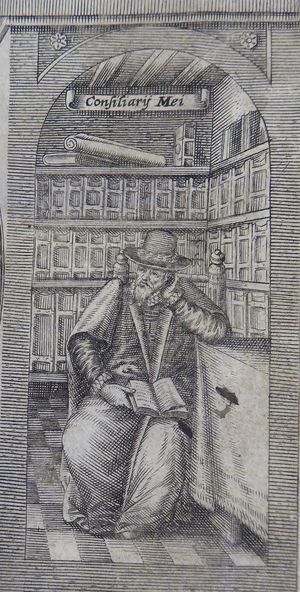Difference between revisions of "John Boys 1571-1625"
m (updated link) |
|||
| (14 intermediate revisions by 3 users not shown) | |||
| Line 1: | Line 1: | ||
__NOTITLE__ | __NOTITLE__ | ||
| − | ===[[name::John]] [[name::BOYS]] [[date of | + | ===[[name::John]] [[name::BOYS]] [[date of birth::1571]]-[[date of death::1625]]=== |
| − | + | [[file:JohnBoys.jpg|thumb|Boys in his study, as depicted on the titlepage of his Workes, 1622]] | |
====Biographical Note==== | ====Biographical Note==== | ||
| − | Born at [[place of | + | Born at [[place of birth::Elmton, Kent]], son of [[family::Thomas Boys]], gentleman. BA [[education::Corpus Christi College, Cambridge]] 1590, MA 1593; he then moved to [[education::Clare College, Cambridge|Clare College]] (BD, 1600, DD 1605). [[occupation::rector|Rector]] of [[location::Betshanger, Kent]], and [[occupation::Master]] of [[organisations::Eastbridge Hospital]], Canterbury, 1597; he was given other Kentish livings during the succeeding years. He was made [[occupation::dean|Dean]] of [[organisations::Canterbury Cathedral|Canterbury]] in 1619, and in 1620 a member of the [[organisations::Court of High Commission]]. Theologically he embraced the pulpit-centred predestinarian Calvinism which was common in the English church around the turn of the 17th century, but he also oversaw the development of musical activity in the Cathedral during his Deanship. |
| − | Boys’s reputation was based partly on his preaching but also on his publication of a systematic series of expositions of scriptural passages used in the English liturgy (originally given as sermons). His collected [[book | + | Boys’s reputation was based partly on his preaching but also on his publication of a systematic series of expositions of scriptural passages used in the English liturgy (originally given as sermons). His collected [[book title::''Workes'']] were published in [[date of publication::1622]], and a further [[author::volume]] of [[book title::''Remaines'']] in [[date of publication::1631]]. |
====Books==== | ====Books==== | ||
| − | Although we have no direct evidence of the size of Boys’s library, and few surviving books are known, evidence of his likely possession of a sizeable collection for his time can be deduced not only from his writings, but also from visual representations. His marble memorial in [[organisations::Canterbury Cathedral]] depicts him surrounded by books, and the engraved | + | Although we have no direct evidence of the size of Boys’s library, and few surviving books are known, evidence of his likely possession of a sizeable collection for his time can be deduced not only from his writings, but also from visual representations. His marble memorial in [[organisations::Canterbury Cathedral]] depicts him surrounded by books, and the engraved title page to the [[date of publication::1622]] [[book title::''Workes'']] includes a vignette of Boys in his study, against a background of bookshelves. Examples: Canterbury Cathedral Library W/H-2-28/29. |
====Characteristic Markings==== | ====Characteristic Markings==== | ||
| − | Canterbury Cathedral Library W/H-2-28/29, a copy of | + | Canterbury Cathedral Library W/H-2-28/29, a copy of Henry Ainsworth's [[book title::''Annotations'']], [[date of publication::1622]], has "Jo: Boys Feb. 27 1623" on the flyleaf. |
====Sources==== | ====Sources==== | ||
<div id="sourcelist"> | <div id="sourcelist"> | ||
| − | *[http:// | + | *[http://cclprovenance.djshaw.co.uk/index.php?title=John_Boys Canterbury Cathedral Library provenance research]. |
*Collinson, P. et al (eds), ''A history of Canterbury Cathedral'', 1995. | *Collinson, P. et al (eds), ''A history of Canterbury Cathedral'', 1995. | ||
*Richardson, William. [https://doi.org/10.1093/ref:odnb/3144 "Boys, John (bap. 1571, d. 1625), dean of Canterbury."] ''Oxford Dictionary of National Biography''. | *Richardson, William. [https://doi.org/10.1093/ref:odnb/3144 "Boys, John (bap. 1571, d. 1625), dean of Canterbury."] ''Oxford Dictionary of National Biography''. | ||
| Line 25: | Line 25: | ||
[[Category:Clergy]] | [[Category:Clergy]] | ||
[[Category:Inscriptions]] | [[Category:Inscriptions]] | ||
| + | [[Category:All Owners]] | ||
Latest revision as of 04:51, 1 September 2023
John BOYS 1571-1625
Biographical Note
Born at Elmton, Kent, son of Thomas Boys, gentleman. BA Corpus Christi College, Cambridge 1590, MA 1593; he then moved to Clare College (BD, 1600, DD 1605). Rector of Betshanger, Kent, and Master of Eastbridge Hospital, Canterbury, 1597; he was given other Kentish livings during the succeeding years. He was made Dean of Canterbury in 1619, and in 1620 a member of the Court of High Commission. Theologically he embraced the pulpit-centred predestinarian Calvinism which was common in the English church around the turn of the 17th century, but he also oversaw the development of musical activity in the Cathedral during his Deanship.
Boys’s reputation was based partly on his preaching but also on his publication of a systematic series of expositions of scriptural passages used in the English liturgy (originally given as sermons). His collected Workes were published in 1622, and a further volume of Remaines in 1631.
Books
Although we have no direct evidence of the size of Boys’s library, and few surviving books are known, evidence of his likely possession of a sizeable collection for his time can be deduced not only from his writings, but also from visual representations. His marble memorial in Canterbury Cathedral depicts him surrounded by books, and the engraved title page to the 1622 Workes includes a vignette of Boys in his study, against a background of bookshelves. Examples: Canterbury Cathedral Library W/H-2-28/29.
Characteristic Markings
Canterbury Cathedral Library W/H-2-28/29, a copy of Henry Ainsworth's Annotations, 1622, has "Jo: Boys Feb. 27 1623" on the flyleaf.
Sources
- Canterbury Cathedral Library provenance research.
- Collinson, P. et al (eds), A history of Canterbury Cathedral, 1995.
- Richardson, William. "Boys, John (bap. 1571, d. 1625), dean of Canterbury." Oxford Dictionary of National Biography.
